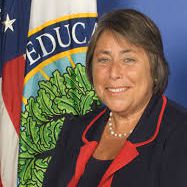A Lifecycle Approach to Putting Higher Education within Reach
Written by Martha J. Kanter, New York UniversityI think by far the most important bill in our whole code is that for the diffusion of knowledge among the people. No other sure foundation can be devised for the preservation of freedom and happiness.
— Thomas Jefferson to George Wythe, 1786
A generation ago, the United States ranked first in the world in the percentage of adults who were college graduates. Our international competitiveness was unmatched, and our universities were the envy of the world. Today the United States is not even among the top 10 nations in terms of college graduates.1 Our young adults perform at abysmally lower rates in literacy, numeracy, and problem solving than their peers in 21 other countries.2 This dramatic decline in academic achievement has serious implications for all of us — for the individuals whose education attainment stalls out too early, for their families, and for the nation as a whole.
Georgetown University’s Center on Education and the Workforce projects that by 2020, 65 percent of our nation’s workforce will need an associate’s, undergraduate, or advanced degree to meet the needs of the economy.3 Yet even as postsecondary education becomes increasingly essential for meaningful workforce participation, two powerful trends from the opposite direction are also intensifying: the growing cost of higher education and the growing economic inequality of our society.
Between 1984 and 2007, college tuition and fees increased by 439 percent, far outstripping the 106 percent increase in the general cost of living. By way of comparison, the cost of medical care, the sector showing the second largest increase, grew by “only” 251 percent during that period.4 Meanwhile, the gap between rich and poor in the United States has also grown substantially during the past decade. The richest 1 percent of Americans received 65 percent of the nation’s income growth from 2002 to 2007. Since 2009, that proportion increased to 95 percent, a period when wages have stagnated while stocks and corporate profits have soared.5
This general economic disparity is reflected in educational attainment. Approximately 80 percent of high school graduates from high-income families enroll in college, and more than one-half of them attain a college degree. By contrast, only 29 percent of students from low-income families matriculate, and fewer than one in ten go on to graduate.6 The bottom line is that students from low-income families earn bachelor’s degrees at one-eighth the rate — 9 percent versus 75 percent — of their more advantaged counterparts by age 24.
All of these trends have been years in the making, but their convergence has serious implications for our country. An economically stable life requires a good job. Good jobs, in turn, increasingly will require post-secondary education — but at the same time, postsecondary education is becoming increasingly out of reach.
The United States was never intended to be a traditional class-bound society where people are born to a certain station in life and remain there all their days. Yet this may become our reality. Already, more than 40 percent of the poorest American children (those in the bottom quintile) remain there into adulthood, as does nearly the same percentage of the children born into the richest quintile.7
Other contributors to this volume have noted the ways that higher education both reflects and reinforces the status quo. Regina Stanback Stroud’s essay places the role of poverty and its impact on school completion squarely at the center of this discussion. Dedrick Asante-Muhammad writes about this correlation’s racial and class overtones — and its implications as the U.S. moves toward becoming a “majority minority” nation.
This vision of our Founding Fathers — of education as the bedrock for the freedom and happiness of the people — requires renewed commitment from every generation. Our urgent task now is to ensure that our nation’s young adults, including and indeed especially those from less advantaged families, have the resources to pursue the education they will need to live the twenty-first century version of the “free and happy” life envisioned by our nation’s founders 230 years ago.
What America’s founders believed as a matter of principle has been amply borne out by scholarly research. Educated people are indeed significantly happier and healthier than uneducated people, and the higher the level of educational attainment, the more significant the differences.8 Educated people form more stable families. This has been so for at least the past 70 years and, again, the higher the rate of educational attainment, the more significant the difference.9 Better-educated people participate more fully in civil society and politics.10 All of these outcomes contribute to the nation’s social capital — a term the founders might not have used but that captures the humanizing and civilizing effects they so highly esteemed.
Getting to the Starting Line
A critical first step is to help America’s families navigate the complex process of financing a college education. Along with the escalating costs of tuition, fees, and living expenses, college today is too often an exercise in confusion for families. Colleges advertise the sticker price for tuition that varies too often from year to year. But the majority of schools use institutional, state, or federal student aid to discount this price. When college costs are advertised, the published prices are often different from the net price after discounts are applied from institutional scholarships, endowments, state aid or federal aid. Families see the sticker price and many turn away thinking it is out of reach, not understanding that the real price may be lower. Furthermore, states can and do vary tuition rates and fees for the public community colleges and universities for which they are responsible. Families, especially those from lower-income, less financially sophisticated communities, become justifiably frustrated about even understanding the actual cost of college, much less figuring out how to pay for it.
The Federal Student Loan Program, intended as a powerful solution to the financial barriers to college, also remains intimidating despite the reforms introduced with the Free Application for Student Aid, a simplified federal loan and grant application form. Subsidized and unsubsidized Stafford loans, PLUS loans, and Perkins loans all have different eligibility conditions and terms, interest rates, and consequences for loan defaults or delinquency. Many students — again, especially those from lower-income families — have trouble decoding the distinctions and may end up burdened with excessive debt.
In addition, many students fail to take full advantage of the available higher education tax benefits including the American Opportunity Tax Credit, the Lifetime Learning Credit, Tuition Tax Deduction Credits, 529 Plans, loan forgiveness options, and interest deductions from student loans. About one in six Americans fails to apply for or use the tax benefits to which they are entitled,11 leaving money on the table that potentially could make a significant difference in paying for college.
Just raising awareness about tax credits, loan consolidation, and repayment options could ease the burden on overwhelmed families for whom all of these programs remain a mystery. But a broader strategy is required. American families need help navigating the technical aspects of financing a college education, to be sure. But even more, our nation’s students, especially those from lower-income segments, need to see college as a realistic option — indeed, as an expectation for success in the twenty-first century.
A Lifecycle of Interventions
For more than a generation, numerous studies have documented the success of Children’s Savings Accounts, or CSAs, in substantially increasing college enrollment and graduation rates for students from low-income families. While there are various instruments that allow people to save on a tax-advantaged basis for their children’s (or other loved one’s) higher education,12 CSAs go one step further as universal (or near-universal) accounts seeded with an initial deposit, augmented by savings matches or other incentives, and used toward asset development after the age of 18, typically for postsecondary educational expenses.
Children with even a small amount of educational savings (e.g. less than $500) are 3 times more likely to enroll in college and 2.5 times more likely to graduate, than a child with no savings.13 The working hypothesis is that the sheer existence of the CSA creates a college-bound mindset for both the child and his or her family, and that this psychologically powerful image shapes expectations and achievements in positive ways.
More recently, two additional promising new approaches for increasing college access, enrollment, and graduation rates have emerged. First, College Promise Programs (CPP) allow students to complete a certificate, an associate’s degree, or the first two years or more of a bachelor’s degree at no cost or significantly reduced cost. Early CPP experiences in Tennessee and Chicago inspired the Obama administration to propose a nationwide program to make two years of community college available to all eligible students debt-free. A subsequent proposal from scholars at the Center for American Progress recommended extending the model to all two- and four-year institutions in willing states. Second, Performance-Based Funding (PBF) incentives are an alternative disbursement model for student aid. Under the traditional model, grants to low-income students are disbursed as lump sums at the beginning of the semester. Using a PBF incentive, student aid can be released in smaller but more frequent payments, like a paycheck designed to increase college retention and persistence rates. Another PBF incentive is bonus payments to students and institutions for achieving good grades and completing their programs of study.
All three of these approaches — CSA, CPP, and PBF models — are innovative yet entirely pragmatic policy efforts to raise the educational levels and outcomes for the nation’s students. The challenge now is to put the pieces together — to integrate these policies into a unified whole and then to roll out that lifecycle approach on a large scale.
In the spring of 2012, the U.S. Department of Education announced a call for widespread, scalable CSAs accompanied by financial education strategies to encourage students and families to embrace college-going cultures leading to social, civic, and economic prosperity. This call was based on an understanding that without a comprehensive, holistic approach to building financial capability, families would see college as a pipe dream rather than a real opportunity for them or their children. The department emphasized that the federal government, the states, and other stakeholders could take bolder steps to strengthen college opportunity by consolidating the piecemeal efforts.
The good news is that some of that work to streamline programs is already underway. Scholars and local, state, and federal policymakers are proposing student aid redesign plans that could align existing resources (e.g., the federal Pell grant program, subsidized loans, and income-based repayment options) with the new and existing College Promise program incentives. Adding CSAs to this mix, especially if accompanied by intensive outreach efforts to educate families about their benefits, would increase families’ and students’ financial capability, set the expectation for college enrollment, and build a nest egg to defray education costs. If well structured, combining the best-in-breed CSA models, College Promise models, and PBF strategies would provide low-income students the opportunity to afford and complete an undergraduate education while also making college more affordable for the middle class.
Putting the Pieces Together: A Call to Action
The time is ripe for putting the pieces together — to convene the nation’s most distinguished thought leaders and experts to build on the promising initiatives that are already underway all over the country. This effort would create a model that communities, states, and the federal government could adopt fully or in part to build financial capability and to increase college access, enrollment, and graduation rates. The model would integrate CSA, CPP, and PBF research, incentives, and practical applications into a coherent action plan with intended targets and outcomes.
If the integrated model works, the administrative cost savings could be significant. But more importantly, the “one stop shop” would provide families who currently must pursue multiple and often confusing channels with a single entry point instead. The proposed integrated model must emphasize “skin in the game” for all stakeholders in America’s future, including families, education, business, government, philanthropy and nonprofits. And it must be fundamentally premised on practicality and effectiveness. For that reason, the research component is critical (as it is for any evidence-based initiative), particularly around PBF and the Promise programs.
The College Promise models underway are varied, and there has not yet been a meta-analysis that compares them based on student outcomes. PBF was first implemented in Ohio in the 1990s, but was later rescinded by the legislature before a meaningful body of research could be developed. Although, as noted, a solid body of research demonstrates the effect of educational savings on increasing college aspirations and enrollment, a rich avenue for future study will be the effect of CSAs on college performance or post-graduation outcomes, such as employment, life satisfaction, and civic engagement.
To build the evidence base that CSAs make a difference in encouraging a college-going culture, increasing college affordability, and enabling the larger goal of investing in education to produce a more educated society than in centuries past, several College Promise prototypes designed to increase the success of low-income students offer a path forward.
- Arizona Earn to Learn provides eligible students with financial education, one-on-one financial coaching, college readiness training, and ongoing financial literacy support. Students must also save $500 of their own money through an Individual Development Account, a commitment savings product proven to help low-income people build assets. When a student completes the program requirements, he or she receives an 8:1 match of $4,000 in scholarship money per academic year ($2,000 from the federal government’s Assets for Independence program and $2,000 from one of the three Arizona state universities).
- City of Chicago Promise provides scholarships for tuition, fees, and books for all students who graduate from the Chicago public schools with at least a 3.0 grade point average and who place into college-level mathematics and English at the City Colleges of Chicago.
- Cuesta College, a community college in California, announced in 2014 that it would waive tuition and fees for the first year for all graduates of a local county high school district. This year, they added the open textbooks initiative to further limit college costs. The Cuestonian reported that students taking Professor Nielson’s U.S. history class used a textbook from Openstax College, a nonprofit organization sponsored by Rice University dedicated to providing students with free, high-quality textbooks across the nation.
- Denver Scholarship Program offers need-based scholarships to qualified graduates of Denver public schools. The scholarships can be used at four-year colleges and universities, community colleges, or technical schools.
- Kalamazoo Promise pays up to 100 percent of college tuition at state colleges and universities for graduates of the city of Kalamazoo (Michigan) public high schools. Kalamazoo Promise recently announced a partnership with the Michigan Colleges Alliance, a consortium of 15 private liberal arts colleges, under which the members of the Alliance have agreed to absorb the difference in cost between their tuition and that of a public university for qualifying students.
- Tennessee Promise guarantees Tennessee high school graduates with two years at community college or a college of applied technology absolutely free of tuition or fees. After graduating from community college, if students choose to attend a four-year institution, the state’s transfer pathways program makes it possible for them to start as a junior. By getting their first two years for free, the cost of a four-year degree is cut in half.
- West Virginia Promise provides eligible high school graduates with up to $4,750 for tuition at state public or private institutions.
To date, there are more than 50 CPPs across the nation. These models are ripe for replication and expansion to further the opportunity for every American to earn a college degree or certificate, ensuring that the nation will have a highly educated workforce and more prosperous communities in the years ahead.
What’s at Stake
Our Founding Fathers valued education beyond its material benefits, understanding how indispensable it is for the nation to remain free and self-governing. But those material benefits are not trivial. The average college graduate pays almost twice as much in taxes each year as the average high school graduate, and the average holder of a professional degree pays almost twice as much as the college graduate.14 College graduates also benefit their local economies. A percentage point increase in the supply of college graduates raises wages for high school graduates by 1.6 percent, and high school drop-outs see wage increases of 1.9 percent.15 And of course, the benefit to the individuals themselves is dramatic. As Sarah Bloom Raskin points out in her contribution to this volume, one or two years of postsecondary education from a community college or training program can boost a person’s lifetime earnings by more than $170,000 compared with a high school diploma alone, and a four-year degree pushes the spread to more than $500,000.16
The correlation between education and upward economic mobility has never been higher, and stakeholders across the spectrum recognize that reality. The Social Mobility Index (SMI), a joint venture between CollegeNet (a higher education technology company) and Payscale (a compensation data firm) was launched explicitly to rank schools according to how well they prepare disadvantaged students to start careers free of onerous debt. Membership in the Complete College America (CCA) Alliance of States has doubled during the past four years to include 33 states and the District of Columbia. CCA members commit to state- and campus-specific degree completion goals by 2020, with an emphasis on tracking low-income and minority students’ progress.
All of these developments are vital because, for the first time in at least 50 years, a majority of public high school students now come from low-income families.17 Unless we are prepared to write off 40 million children, or to leave their futures to chance, the debate can no longer be about whether to radically expand access to higher education. It can only be about how.
Critical momentum has already been gathering to experiment, find what works, and then build on it to make college a reality for the young people and adults who were left out of the college pipeline.18 Putting the existing pieces together into a coherent whole is a logical next step to drive down costs, increase access, achieve higher graduation rates, and let us see, once the puzzle is put together, what more needs to be done.
But as with any meaningful change, it will ultimately come down to a question of will. The entire country — politicians, policymakers, experts, the business community, and ordinary taxpaying Americans — must decide whether to sustain higher education as a public good, vital to our economic and civic life at home and to our strength among the nations of the world.
NOTES
- In the most recent OECD rankings, the United States is #12 in the percentage of adults with undergraduate degrees aged 25–34. Organisation of Economic Cooperation and Development, 2013 Education at a Glance: Country Note (2013).
- Madeline Goodman, Anita Sands, and Richard Coley, “America’s Skills Challenge: Millennials and the Future.” (Princeton, NJ: ETS Center for Research on Human Capital and Education, 2015).
- Anthony Carnevale, Andrew Hanson, and Artem Gulish, “Failure to Launch: Structural Shift and the New Lost Generation.” (Washington, DC: Georgetown University Center on Education and the Workforce, September 2013).
- National Center for Public Policy and Higher Education, “Measuring Up 2008: The National Report Card on Higher Education.” (San Jose, CA: NCPPHE, 2008).
- Thomas Piketty and Emmanuel Saez, “Top Incomes and the Great Recession: Recent Evolutions and Policy Implications.” Paper presented at the 13th Jacques Polak Annual Research Conference, Washington, DC: International Monetary Fund, November 8–9, 2012.
- Martha Bailey and Susan Dynarski, “Inequality in Postsecondary Attainment.” In Whither Opportunity: Rising Inequality, Schools, and Children’s Life Chances, edited by Greg Duncan and Richard Murnane (New York: Russell Sage Foundation, 2011).
- Pew Charitable Trusts, Pursuing the American Dream: Economic Mobility Across Generations (July 2012).
- Michael Hout, “Social and Economic Returns to College Education in the United States,” Annual Review of Sociology, 38 (2012): 394.
- Claude S. Fischer and Michael Hout, Century of Difference: How America Changed in the Last 100 Years (New York: Russell Sage Foundation, 2006).
- See, e.g., Robert Putnam, Bowling Alone: The Collapse and Revival of American Community (New York: Simon & Schuster, 2000); Sidney Verba, Kay Schlozman, and Henry Brady, Voice and Equality: Civic Voluntarism in American Politics (Cambridge, MA: Cambridge University Press, 1995).
- As pointed out in an August 2014 letter to U.S. Secretary of Education Arne Duncan from 12 U.S. senators urging the Obama administration to raise awareness about higher education tax credits.
- Two common forms of CSAs are Education Savings Accounts (also known as Coverdell accounts), which are limited to individuals whose adjusted gross income is less than $110,00 and state-sponsored 529 accounts (every state offers at least one 529 plan).
- William Elliott, “Small-Dollar Children’s Savings Accounts and Children’s College Outcomes,” Children and Youth Services Review, 35 (3) (2013): 572–585.
- Exact figures are: $7,100 for the high school graduate; $13,000 for the college graduate; and $25,600 for the professional. The College Board, Education Pays (2010).
- Enrico Moretti, “Estimating the Social Return to Higher Education: Evidence from Longitudinal and Repeated Cross-Sectional Data,” Journal of Econometrics, 121 (2004): 175–212.
- Michael Greenstone and Adam Looney, “Where is the Best Place to Invest $102,000 — in Stocks, Bonds, or a College Degree?” (Washington, DC: Brookings Institution, June 25, 2011).
- Steve Suitts, Pamela Barba, and Katherine Dunn, “A New Majority: Low Income Students Now a Majority in the Nation’s Public Schools.” (Atlanta: Southern Education Foundation, January 2015).
- The traditional profile of the college student — matriculating straight from high school at age 18 and graduating at age 22 — is increasingly a thing of the past. The average age of a college student today is 26, and most are working part- or even full-time while taking classes. See Louis Soares, “Post-Traditional Learners and the Transformation of Postsecondary Education: A Manifesto for College Leaders.” (Washington, DC: American Council on Education, 2013).




